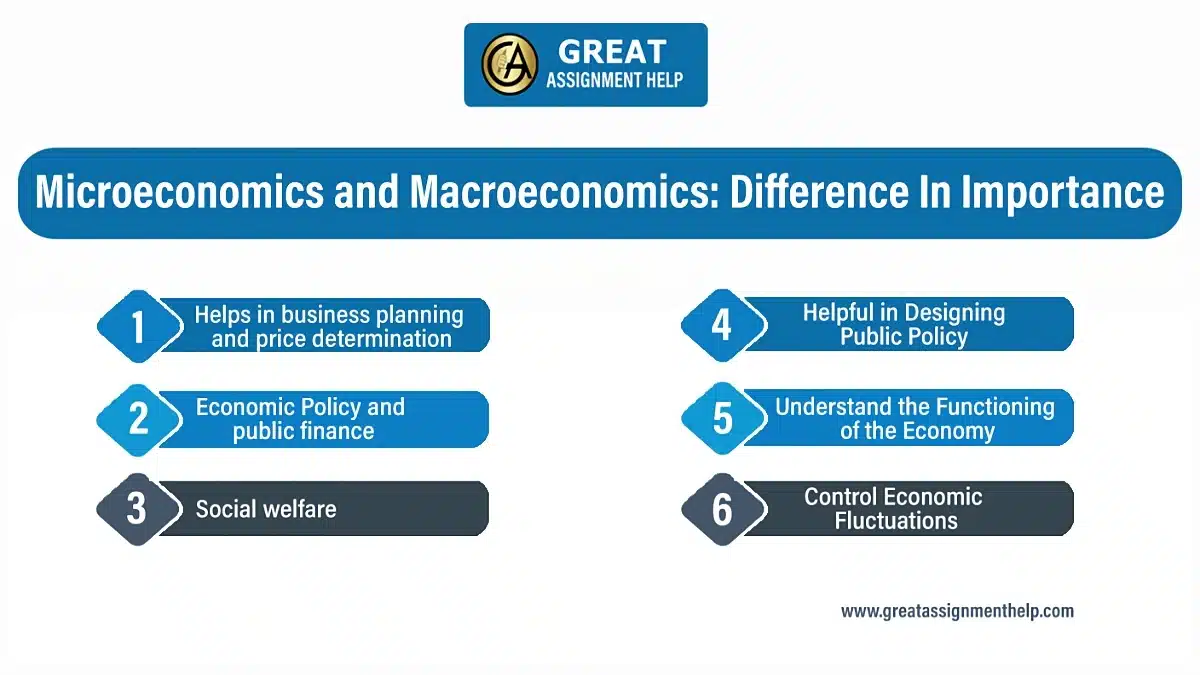The terms microeconomics and macroeconomics sound quite similar. Therefore, most students often confuse them. The truth is these two parts of economics deal with completely different things. While microeconomics is concerned with the actions of individual units like a person, a firm, a household, a market, or an industry, macroeconomics considers things on the whole. You can never use macroeconomics to deal with a single unit. Instead, it is a combination of multiple things like firms, households, nations, industries, markets, etc. If you are intrigued to learn more about the differences between microeconomics vs. macroeconomics, then read this blog. Here, we have detailed the differences between the two sections of economics based on the concepts, advantages, disadvantages, uses, and many other factors.
What is Economics?
It can be difficult to find the differences between microeconomics vs. macroeconomics or ideate the concepts of the two branches of economics unless you know what economics is. Economics is a part of social science that studies how humans put their efforts together to acquire goods and services in exchange for limited resources and satisfy their needs, wants, and desires. Economics also studies the methods human applies to share the gained goods and services among themselves. It has two broad branches, microeconomics, and macroeconomics.
Learn the Differences between Microeconomics and Macroeconomics
Here is a comparative study of the differences between microeconomics vs. macroeconomics.
Microeconomics vs. Macroeconomics: Difference in concept
Here is the difference in the concepts of microeconomics and macroeconomics
What is Microeconomics?
Microeconomics is the branch of economics that focuses on the actions and activities of the singular economic agents in the economy like consumers, families, industry, firms, etc. It determines how the controlled resources are distributed among various individuals to gratify their needs. It also specifies the environment to make the best use of the resources, to attain the greatest output and social welfare.
Here, demand plays a crucial function in examining the amount and the price of a product together with the price and quantity of related commodities, like complementary goods and substitute products. It helps to make a sensible decision concerning the distribution of insufficient resources, and their alternative uses.
- Microeconomics also explores the following concepts
- How do individuals and households use up their income?
- How do people decide on the amount to save for future emergencies?
- What type of goods and services best fulfills their needs and wants, in the limited income?
Apart from that, microeconomics also helps to determine various factors concerning a manufacturing or corporate firm. For example:
- What goods and how many goods an organization should manufacture to sell?
- At what price the firm must offer its products and services to the target audience?
- What sources of finance should a firm use to begin or operate the business?
- How many and at what rate the workers must be hired to work for the firm?
- When should the firm spread out, scale back, and close the business?
What is Macroeconomics?
In macroeconomics, the whole economic occurrence or the overall economy is discussed. Essentially, it concentrates on the actions and activities of collective variables and deals with those issues that have an impact on the entire economy.
It includes regional, national, and international economies and focuses on the prominent areas of the economy like the following:
- Unemployment
- Poverty
- General Price level
- Total consumption
- Total savings
- Gross Domestic Product
- Imports and exports
- Economic growth
- Globalization
- Monetary or fiscal policy
Macroeconomics also deals with the other concepts listed below:
- How the equilibrium is achieved as a result of modifications in the macroeconomic variables?
- What is the degree of unemployment, deficiency, and inflation in the country?
- What are the issues that give rise to speeding up or slowing down the economy?
- The level of economic activity in a country.
- What is the quality of living of people in the country?
- What is the cost of living in the country?
Further, macroeconomics talks about the issues that the country goes through and assists in resolving them. In this manner, it enables the country to perform efficiently.
Also read: Excellent Microeconomics Research Paper Topics
Microeconomics vs. Macroeconomics: Type of Economics they Handle
Microeconomics and macroeconomics both handle financial systems but at different levels. Here is a difference between the two.
- Microeconomics: It studies a specific segment of an economy, for example, an individual, household, firm, or industry. It examines the concerns of the economy at an individual level.
- Macroeconomics: It investigates aggregate units of the entire economy. It does not talk about a specific unit instead it studies broad economic issues, for instance, national income, general price level, total consumption, etc.
Microeconomics vs. Macroeconomics: Types of Issues They Deal With
Here are the differences between microeconomics and macroeconomics based on the type of issues they deal with
- Microeconomics: It is concerned with operational or internal issues
- Macroeconomics: It is concerned with external issues.
Microeconomics vs. Macroeconomics: Fundamental tools
The basic tools used in microeconomics are different from the ones used in macroeconomics. Here is the difference between the two.
- Microeconomics: The fundamental tools used in microeconomics are demand and supply.
- Macroeconomics: Average demand and supply are the primary tools of macroeconomics.
Microeconomics vs. Macroeconomics: Scope
Microeconomics and macroeconomics cover different subjects in the scope of their dealings. Here is the difference between the two.
- Microeconomics: It takes care of an individual product, firm, household, industry, wages, prices, etc.
- Macroeconomics: It takes in hand aggregates like national income, national output, price level, total consumption, total savings, total investment, etc.
Microeconomics vs. Macroeconomics: Types of Impacts They Deal With
Both microeconomics and macroeconomics handle different types of impacts. Here is the difference between microeconomics and macroeconomics based on the impacts they deal with.
- Microeconomics: It deals with the impacts of issues like how the price of a particular commodity will affect its quantity demanded and quantity supplied and vice versa.
- Macroeconomics: It covers key concerns of an economy like unemployment, monetary or fiscal policies, poverty, international trade, inflationary increase in prices, deficit, etc.
Microeconomics vs. Macroeconomics: Things it Determines
Microeconomics and macroeconomics determine different things in an economy. Here is the difference between the two:
- Microeconomics: Determine the value of a specific commodity along with the prices of complementary and substitute goods
- Macroeconomics: It helps preserve the general price level, as well as it helps in resolving main economic issues like inflation, deflation, disinflation, poverty, unemployment, etc.
Microeconomics vs. Macroeconomics: Approach Type
Microeconomics and macroeconomics take different approaches to analyzing an economy. Here are the differences between the two.
- Microeconomics: It takes a bottom-up approach
- Macroeconomics: It takes a top-down approach
Also read: Excellent Economics Essay Topics for Students
Microeconomics and Macroeconomics: Advantages
The benefits of microeconomics are in complete contrast to that of macroeconomics. Here are the differences in their benefits.
Advantages of Microeconomics
The following are the pros of microeconomics:
- It assists in determining the cost of a specific product and also the prices of various aspects of production, like land, labor, capital, organization, and entrepreneur.
- It is founded on a free enterprise economy, which indicates the enterprise is free to make decisions.
Advantages of Macroeconomics
Here are the advantages of Macroeconomics:
- It assists in examining the balance of payments along with the reasons for deficit and surplus it.
- It lends a hand in deciding on economic and fiscal policies and resolves the concerns of public finance.
Also read: Macroeconomics Research Topics and Ideas
Microeconomics and Macroeconomics: Drawbacks
The disadvantages of microeconomics are also different from that of macroeconomics. Here are the differences in their drawbacks.
Drawbacks of Microeconomics
Here are the negatives of microeconomics.
- The hypothesis of complete employment is completely unrealistic.
- It only investigates a small part of an economy while a larger section is left untouched.
Drawbacks of Macroeconomics
Here are some prominent drawbacks of macroeconomics:
- Its investigation suggests that the aggregates are homogeneous, but this is not the truth because sometimes the collective values are heterogeneous.
- It deals with only the aggregate variables which keep away from the welfare of the individual.
Microeconomics and Macroeconomics: Significance
Both microeconomics and macroeconomics are important for the society. However, there is a difference in their benefits. Here are the differences.
Importance of Microeconomics
Here is the importance of microeconomics
-
Helps in business planning and price determination
Microeconomics helps business organizations plan their costs, production, etc, and project the demand for the goods to capitalize on their profits. Additionally, it is useful in describing how market mechanism ascertains price in a free market economy. The market forces of demand and supply establish prices of goods and services with no government interference.
-
Economic Policy and Public Finance
Microeconomics helps in developing various policies related to economics, price, tax, etc., and plans for the fiscal welfare of the people and to encourage all-round economic development. For example, it helps the government to decide on implementing various types of taxes and setting the tax rates and amount of tax to be charged to the buyer and the seller.
-
Social welfare
The impact of microeconomics is also observed in meeting the social requirements in various market conditions It not only analyses economic conditions but also studies social needs under different market conditions like monopoly, oligopoly, etc. It explains how optimum social welfare can be gained under perfect competition. Additionally, it studies the impact of taxes on social welfare.
Importance of Macroeconomics
Here is the significance of macroeconomics in an economy
-
Helpful in Designing Public Policy
Macroeconomic concepts and their collectives assist in designing and preparing proper public policies for the government. For the development of productive and sound public policies, the precise and reliable statistics of the combined variables are the first pre-condition. Economic policies are developed for a collection of individuals in place of individuals, so macroeconomics has superior relevance in the development of economic policies.
-
Helpful to Understand the Functioning of the Economy
Macroeconomics assists in recognizing the functioning of the economy on the whole. It also helps to understand how the macro variables perform collectively. With the help of macroeconomics, we can examine the input of different sectors in the economy. Macroeconomic variables and their rate of change, dominating sector of the economy, etc., are the main concepts of macroeconomic theory.
-
It Helps to Control Economic Fluctuations
Macroeconomics helps to recognize the reasons for the ups and downs in the economy and it also helps to devise the strategy to analyze them. Economic fluctuations like trade cycle, inflation, deflation, etc. need to be dealt with properly in an appropriate period.
Read more: Excellent Economics Research Topics for Students
Microeconomics vs. Macroeconomics: A Comparison Table
| Basis For Comparison | Microeconomics | Macroeconomics |
| Meaning | The branch of economics that studies the actions of an individual consumer, firm, or family is known as Microeconomics. | The branch of economics that studies the actions of the whole economy, (both national and international) is known as Macroeconomics. |
| Deals with | Singular economic variables | Collective economic variables |
| Business Application | Applied to operational or internal issues | Deals with the environment and external issues |
| Tools | Demand and Supply | Aggregate Demand and Aggregate Supply |
| Assumption | It presumes that all macroeconomic variables are constant. | It presumes that all microeconomic variables are constant. |
| Concerned with | Theory of Product Pricing, Theory of Factor Pricing, and Economic Welfare Theory. | Theory of National Income, Aggregate Consumption, Theory of General Price Level, and Economic Growth. |
| Scope | Covers a range of issues like demand, supply, product pricing, factor pricing, production, consumption, economic welfare, etc. | Covers a variety of issues like national income, general price level, distribution, employment, money, etc. |
| Importance | Helpful in shaping the prices of a product along with the prices of factors of production (land, labor, capital, entrepreneur, etc.) within the economy. | Maintains steadiness in the general price level and resolves the major problems of the economy like inflation, deflation, reflation, unemployment, and poverty as a whole. |
| Limitations | It is based on impractical assumptions, i.e. In microeconomics it is assumed that there is full employment in the society which is not at all possible. | It deals with only the aggregate variables which keep away from the welfare of the individual |
Interdependency of Microeconomics and Macroeconomics
As microeconomics focuses on the allocation of limited resources among individuals, macroeconomics examines how the distribution of limited resources is to be done among many people, so that it will make the best possible use of the scarce resources. Microeconomics studies the individual units, at the same time, macroeconomics studies the aggregate variables.
Both microeconomic and macroeconomic theories prove that a nation can progress economically only when its resources are utilized productively. In this way, we can say that they are interdependent. Further, to have a full understanding of economics, the study of both the two branches is pertinent.
The Bottom Line
Microeconomics and macroeconomics may sound similar but are completely different subjects. At the core, microeconomics deals with the singular variables while macroeconomics handles compound variables. If you are looking for more information on microeconomics vs. macroeconomics, then get in touch with our economics assignment helpers. We have a team of research scholars. They can share with you the nuances of microeconomics and macroeconomics, solve all your queries with accurate solutions, and Macroeconomics Assignment Help you deliver your academic paper in due time. Just state your worries and be at peace.



